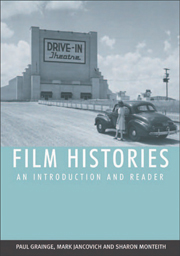Book contents
- Frontmatter
- Contents
- Preface
- Part I Film History from its Origins to 1945
- Part II Film History from 1946 to the Present
- 13 Postwar Challenges: National Regeneration, HUAC Investigations, Divestiture and Declining Audiences
- 14 The Politics of Polarisation: Affluence, Anxiety and the Cold War
- 15 Cinematic Spectacles and the Rise of the Independents
- 16 New Waves, Specialist Audiences and Adult Films
- 17 Radicalism, Revolution and Counter-Cinema
- 18 Modernism, Nostalgia and the Hollywood Renaissance
- 19 From Movie Brats to Movie Blockbusters
- 20 The Exhibitors Strike Back: Multiplexes, Video and the Rise of Home Cinema
- 21 Postmodernism, High Concept and Eighties Excess
- 22 Cults, Independents and ‘Guerrilla’ Filmmaking
- 23 From Cinemas to Theme Parks: Conglomeration, Synergy and Multimedia
- 24 Globalisation and the New Millennium
- Bibliography
- Copyright Acknowledgements
- Index
17 - Radicalism, Revolution and Counter-Cinema
from Part II - Film History from 1946 to the Present
Published online by Cambridge University Press: 05 August 2013
- Frontmatter
- Contents
- Preface
- Part I Film History from its Origins to 1945
- Part II Film History from 1946 to the Present
- 13 Postwar Challenges: National Regeneration, HUAC Investigations, Divestiture and Declining Audiences
- 14 The Politics of Polarisation: Affluence, Anxiety and the Cold War
- 15 Cinematic Spectacles and the Rise of the Independents
- 16 New Waves, Specialist Audiences and Adult Films
- 17 Radicalism, Revolution and Counter-Cinema
- 18 Modernism, Nostalgia and the Hollywood Renaissance
- 19 From Movie Brats to Movie Blockbusters
- 20 The Exhibitors Strike Back: Multiplexes, Video and the Rise of Home Cinema
- 21 Postmodernism, High Concept and Eighties Excess
- 22 Cults, Independents and ‘Guerrilla’ Filmmaking
- 23 From Cinemas to Theme Parks: Conglomeration, Synergy and Multimedia
- 24 Globalisation and the New Millennium
- Bibliography
- Copyright Acknowledgements
- Index
Summary
The success of the postwar art cinema reawakened an awareness of the possibilities of cinema, and created a sense of dissatisfaction with established cinematic traditions, particularly those of Hollywood. The second half of the 1960s, therefore, saw a surge in alternative filmmaking around the world. This period also witnessed the growth of left-wing radicalism as revolutionary struggles in the Third World inspired one another and motivated student radicalism in Europe and the United States.
Stylistically, this radicalism manifested itself in two main ways. On the one hand, there was an interest in both realism and documentary, in which filmmakers sought to engage audiences politically by exposing social processes and conditions. On the other hand, there was an interest in avant-garde strategies that were designed to challenge audiences' perceptions and question the ideological workings of cinema itself. While these two trends were often opposed to one another in rhetoric, they were rarely as distinct as this rhetoric might suggest. The realists and documentary filmmakers were often highly experimental while the avant-gardists often tackled overtly political content.
For example, The Battle for Algiers (1965) is often presented as a key impetus in the development of Third World cinema. Although directed by an Italian director, Pontecorvo, it was made by the Algerian government as a way of celebrating its independence from France after a long and bitter struggle.
- Type
- Chapter
- Information
- Film HistoriesAn Introduction and Reader, pp. 392 - 407Publisher: Edinburgh University PressPrint publication year: 2007



